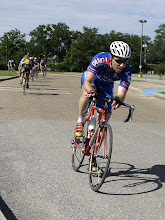Mechanical Musings
It's time to start some hard core thinking again. I'm collaborating with a another bike fitter/coach friend of mine. We are working to create a definition effective pedaling. These are the times that I wish I were Greek. As I understand it, the Greek language has the greatest ability articulate ideas. I guess you could say that it has the greatest granularity. However, at present, I'm stuck with English.
I don't think the definition has fully incubated but I can tell you one element is defined by the type of muscular contractions that are involved in bicycle pedaling. Before I do this, let me define the three different types of contractions.
Concentric: Lifting a cup of coffee. The act of lifting in this case requires that the biceps muscle shorten and bend the elbow. A muscle that contracts and shortens is performing a concentric contraction.
Isometric: Holding a cup of coffee. The act of holding the cup without lifting or lowering requires that the biceps hold the contraction but maintain one length. A muscle that contracts yet remains the same length is performing an isometric contraction.
Eccentric: Lowering the cup of coffee. The active of lowering the cup while controlling the descent requires that the biceps lengthen while it contracts to lower the cup slower than gravity would "pull" it. A muscle that contracts while lengthening is performing an eccentric contraction.
Eccentrics by their very nature dampen or absorb force much like a shock absorber.
The act of pedaling is concentric in nature. That means that muscles should be either "on" and shortening or "off". Concentric muscle contractions express force, they do not dampen.
Here's where it gets a bit confusing. Some might say that muscles are on while they are lengthening(eccentric) like the gastrocnemius or rectus femoris during the upstroke or the biceps femoris(long head) and semitendonosis on the upstroke. However, these are all two joint muscles and have the capacity to operate or effectively control motion at multiple joints. So, when examining the muscle, it's important to define the activity is that is occurring. For example, the gastronemius effectively flexes the knee on the upstroke but the anterior tibialis prevents it from plantar flexing the foot when the foot has just past dead bottom center of the stroke.
Now that we've covered these areas, to my point. An effective pedal stroke should be be devoid of eccentric muscle contraction. In fact, the presence eccentric muscle contraction serves to do two things. It absorbs force and it causes the riders center of gravity to change. Both of these effects are bad. Absorbing force is pretty straight forward however, changes in the center of gravity cause the bike to change direction. Continual changes in direction require continual redirection of the bike and poor bike control.
In fact, absorbing force and challenges to the center of gravity are on a sliding scale. The greater degree that a rider absorbs force in the lower extremities, the less, the center of gravity will be impacted and vice verse.
This is getting longer than I thought. Next time, I'll finish on some common positioning and or technique mistakes that cause a rider to perform eccentric muscle contractions during the pedal stroke.
Labels: muscle physiology, pedaling technique


0 Comments:
Post a Comment
<< Home